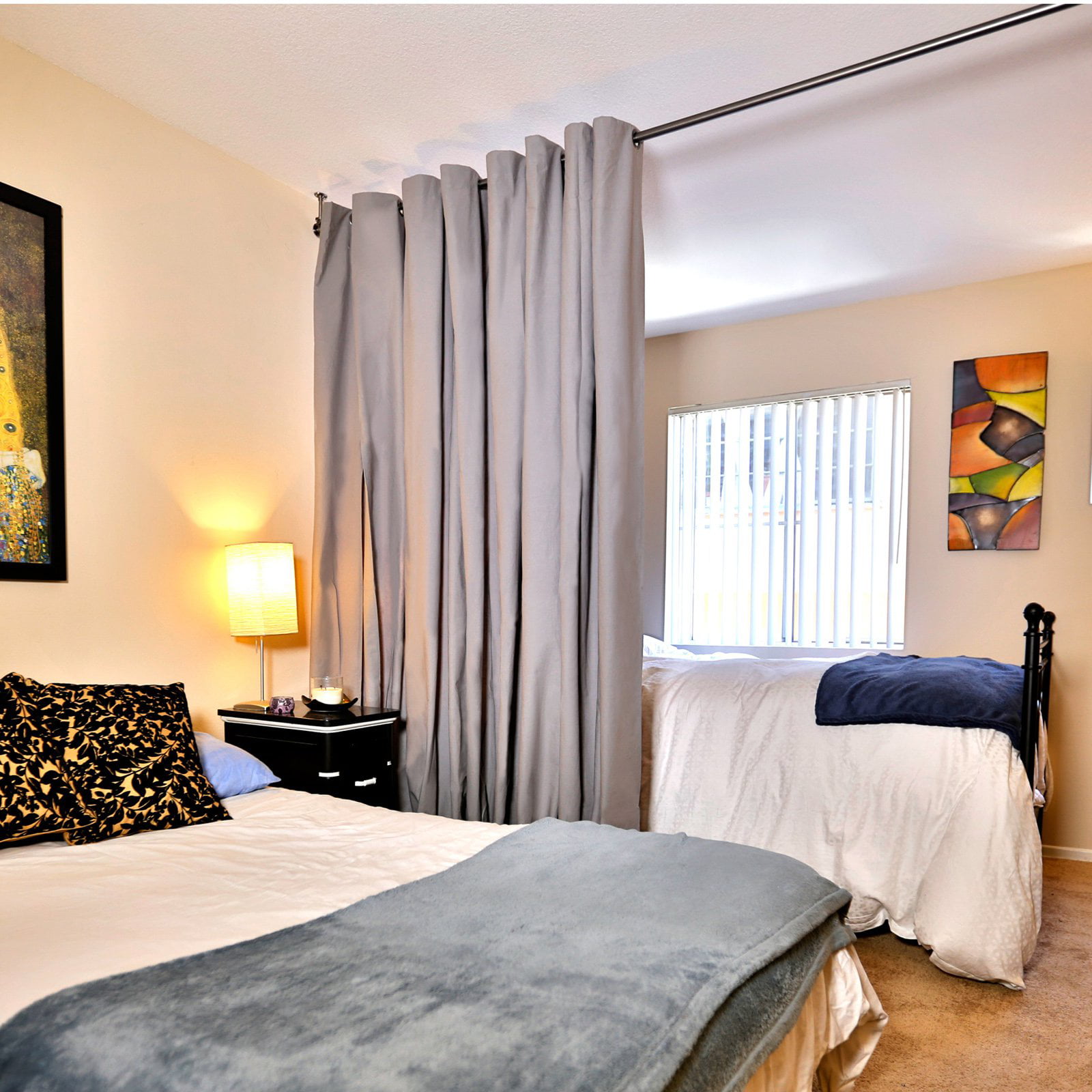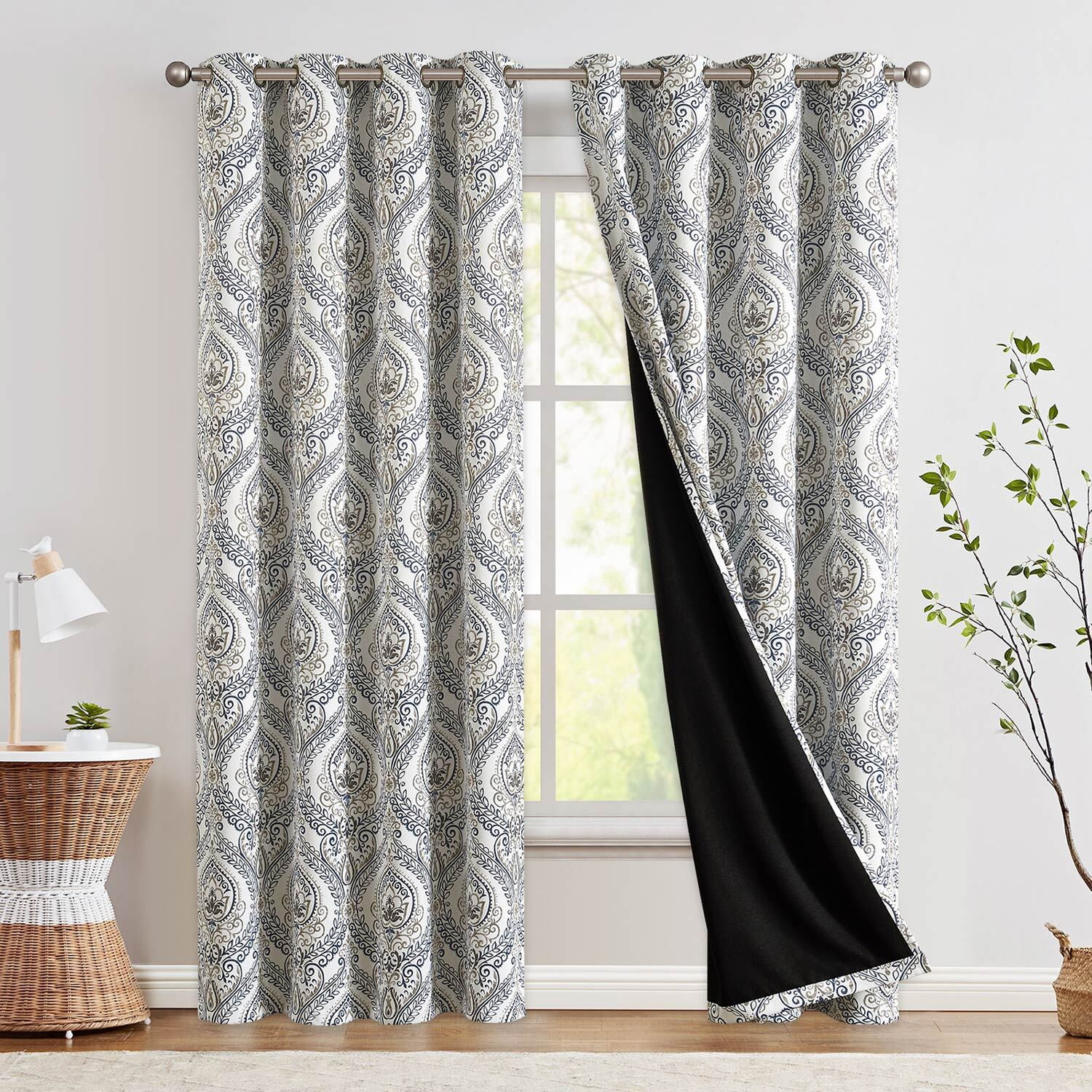Design Considerations

Curtains are a versatile design element that can dramatically alter the feel and functionality of a bedroom. Using curtains as a room divider presents both advantages and disadvantages, influencing the overall aesthetic and practical aspects of the space. This section explores the various design considerations involved in incorporating curtains as a bedroom separator, providing insights into their impact on the room’s ambiance and functionality.
Impact of Curtain Choices
Curtain choices significantly impact the overall feel and functionality of a bedroom. They can influence the amount of natural light, privacy, and sound insulation, as well as the visual appeal of the space.
Choosing the right curtains can enhance the bedroom’s aesthetics and functionality.
- Light Control: Sheer curtains allow ample natural light, while blackout curtains block out most light, creating a darker and more private environment.
- Privacy: Thick curtains provide more privacy, while sheer curtains offer a more airy and open feel.
- Sound Insulation: Heavy curtains can help reduce noise levels, creating a more peaceful atmosphere.
- Visual Appeal: Curtains add visual interest and can complement existing décor, enhancing the bedroom’s overall aesthetic.
Types of Curtains for Bedroom Separation
Various curtain styles and materials are suitable for separating a bedroom. The choice depends on the desired level of privacy, light control, and aesthetic appeal.
- Sheer Curtains: These curtains offer a light and airy feel, allowing natural light to filter through while providing a degree of privacy.
- Blackout Curtains: These curtains are ideal for blocking out light and creating a dark and private environment, perfect for bedrooms with windows facing busy streets or for promoting sleep.
- Room Divider Curtains: These curtains are specifically designed for room separation and often feature heavier fabrics and more substantial hardware for stability.
- Panel Curtains: These curtains consist of multiple panels that can be easily adjusted to create different levels of privacy and light control.
Choosing Curtains to Complement Existing Décor
Curtains should complement the existing bedroom décor to create a cohesive and visually appealing space.
- Color: Choose curtain colors that complement the walls, furniture, and bedding. For a cohesive look, consider using colors that are already present in the room.
- Pattern: Patterns can add visual interest and texture to a room. Choose patterns that complement the existing décor and avoid overwhelming the space with too many patterns.
- Fabric: The fabric choice can influence the overall feel of the room. For example, velvet curtains add a luxurious feel, while linen curtains offer a more relaxed and casual vibe.
- Hardware: Curtain rods and rings should complement the style of the curtains and the overall décor of the room.
Impact of Curtain Colors and Patterns
Curtain colors and patterns can significantly impact the perceived size and ambiance of a bedroom.
- Light Colors: Light colors can make a room feel larger and brighter.
- Dark Colors: Dark colors can make a room feel smaller and more intimate.
- Bold Patterns: Bold patterns can add visual interest and energy to a room.
- Subtle Patterns: Subtle patterns can create a more calming and relaxed atmosphere.
Practical Considerations: Bedroom Separated By Curtains

Separating your bedroom with curtains is a practical and stylish way to create distinct spaces within a single room. But getting the installation right is crucial to ensure the curtains function well and look their best.
Installing Curtains Effectively
Installing curtains effectively is key to their functionality and aesthetic appeal. Here’s a step-by-step guide:
- Measure Carefully: Before purchasing curtains, accurately measure the width and height of the window or doorway you want to cover. Remember to add extra length for pleats and the desired drop below the windowsill or door frame.
- Choose the Right Hardware: The type of curtain rod or track system you select depends on the weight and style of your curtains. For lightweight curtains, a simple tension rod might suffice. However, heavier curtains require a more robust track system or a sturdy curtain rod with brackets.
- Install Hardware Securely: Install the curtain rod or track system securely using the appropriate brackets or screws. Ensure the hardware is level and strong enough to support the weight of the curtains.
- Hang Curtains Properly: Hang the curtains on the rod or track system, ensuring they are evenly distributed and hang smoothly. Use curtain rings or clips that are compatible with your hardware.
Choosing the Right Curtain Rod or Track System
Choosing the right curtain rod or track system is crucial for the functionality and aesthetics of your curtains. Consider these factors:
- Curtain Weight: Heavier curtains require a more robust system. Tension rods are suitable for lightweight curtains, while sturdier rods and tracks are necessary for heavier fabrics.
- Curtain Style: The style of your curtains will influence the choice of hardware. For example, formal curtains may require a more decorative rod, while simple curtains may look better with a minimalist track system.
- Room Style: The overall style of your room should also be considered. For example, a modern room might look better with a sleek, minimalist track system, while a traditional room might benefit from a more ornate curtain rod.
Hanging Curtains for Maximum Privacy and Light Control
Hanging curtains strategically maximizes privacy and light control:
- Length: For maximum privacy, curtains should extend to the floor or slightly below. This prevents light from seeping in from the sides.
- Overlap: Ensure the curtains overlap slightly in the center to block light and provide complete privacy. A slight overlap of 2-3 inches is generally recommended.
- Fabric Choice: Heavier fabrics like velvet or blackout lining offer better light control and privacy than sheer or lightweight fabrics. Consider your needs and preferences when selecting curtain fabric.
Considering Curtain Weight and Material
The weight and material of your curtains significantly impact how they hang and require different installation methods:
- Heavy Curtains: Heavy curtains require a sturdy curtain rod or track system and strong brackets to support their weight. Consider using a double rod system for heavier curtains to distribute the weight evenly.
- Lightweight Curtains: Lightweight curtains can be hung on a simple tension rod or a lightweight track system. These systems are typically easier to install and require less support.
Ensuring Curtains Are Properly Secured
Properly securing your curtains prevents them from falling and ensures they hang smoothly:
- Brackets: Use the appropriate number and type of brackets for your curtain rod or track system. Ensure the brackets are securely attached to the wall or ceiling using screws or anchors.
- Rings or Clips: Choose curtain rings or clips that are compatible with your hardware and the weight of your curtains. Ensure the rings or clips are securely attached to the curtains and slide smoothly on the rod or track.
- Tension Rods: If using a tension rod, ensure it is securely fitted between the walls or window frame. A tight fit is crucial to prevent the rod from slipping and the curtains from falling.
Creative Applications

Curtains offer a versatile and stylish solution for dividing spaces within a bedroom, creating distinct zones for various activities. They allow for flexible and adaptable layouts, catering to individual needs and preferences.
Designing a Bedroom Layout with a Curtain-Separated Area, Bedroom separated by curtains
A curtain-separated area can be effectively incorporated into a bedroom layout for sleeping, work, or relaxation.
- For sleeping, a curtain can be used to create a cozy and private sleeping nook within a larger bedroom. This can be particularly useful for couples who have different sleep schedules or for individuals who prefer a more intimate sleeping environment.
- For work, a curtain can be used to create a dedicated workspace within a bedroom. This can help to separate work from personal life and create a more focused environment.
- For relaxation, a curtain can be used to create a peaceful and secluded reading nook or meditation space within a bedroom. This can provide a quiet and comfortable escape from the hustle and bustle of everyday life.
Using Curtains to Create Different Zones
Curtains can be strategically used to create different zones within a bedroom, enhancing functionality and visual appeal.
- A dressing area can be created by using a curtain to enclose a portion of the bedroom, providing a private space for getting ready. This can be particularly useful for bedrooms with limited space.
- A reading nook can be created by using a curtain to create a cozy and secluded space for reading or relaxing. This can be achieved by placing a comfortable chair and a small bookshelf within the designated area.
Utilizing Curtains to Enhance Privacy and Separation
Curtains provide an effective means of enhancing privacy and creating a sense of separation within a bedroom.
- By using curtains to divide the bedroom into distinct zones, you can create a sense of privacy and seclusion within each area. This can be particularly useful for individuals who share a bedroom with others or who simply prefer a more private space.
- Curtains can also be used to create a sense of separation between the bedroom and other areas of the house, such as the living room or kitchen. This can help to create a more peaceful and relaxing atmosphere in the bedroom.
Creating Visual Barriers with Curtains
Curtains can be used to create a visual barrier without completely dividing a space.
- This can be achieved by using sheer or lightweight curtains that allow light to filter through while still providing a sense of separation. This can be particularly useful for creating a more open and airy feel in a bedroom.
- Another option is to use curtains with different patterns or colors to create a visual contrast between different zones within a bedroom. This can help to define the space and create a more dynamic and interesting design.
Incorporating Unique Design Elements and Textures
Curtains offer a great opportunity to incorporate unique design elements and textures into a bedroom.
- Curtains can be used to add color, pattern, and texture to a bedroom, creating a more visually appealing and personalized space.
- By choosing curtains with different textures, such as velvet, linen, or silk, you can add a touch of luxury and sophistication to a bedroom.
- Curtains can also be used to create a focal point in a bedroom, such as by using a bold pattern or color to draw attention to a particular area.
Bedroom separated by curtains – Bedrooms separated by curtains offer a unique and flexible approach to space division. For those seeking a touch of designer flair, consider incorporating tommy hilfiger bedroom curtains which seamlessly blend style and functionality, adding a touch of sophistication to your space.
This approach not only creates a distinct visual separation but also allows for greater control over light and privacy within the bedroom, making it a versatile and stylish solution.
Dividing a bedroom with curtains can be a stylish and practical solution for creating separate spaces. However, if noise is a concern, you might consider using soundproof curtains for bedroom to ensure a peaceful environment. These specialized curtains are designed to block out unwanted sounds, enhancing privacy and tranquility within your bedroom oasis.
